Abstract
The increasing demand for high-capacity, energy-efficient wireless networks poses significant challenges in maintaining spectral efficiency, minimizing interference, and ensuring sustainability. Traditional direct-link communication suffers from signal degradation due to path loss, multipath fading, and interference, limiting overall performance. To mitigate these challenges, this paper proposes a unified RIS framework that integrates passive and active Reconfigurable Intelligent Surfaces (RISs) for enhanced communication and ambient RF energy harvesting. Our methodology optimizes RIS-assisted beamforming using successive convex approximation (SCA) and adaptive phase shift tuning, maximizing desired signal reception while reducing interference. Passive RIS efficiently reflects signals without external power, whereas active RIS employs amplification-assisted reflection for superior performance. Evaluations using realistic urban macrocell and mmWave channel models reveal that, compared to direct links, passive RIS boosts SNR from 3.0 dB to 7.1 dB, and throughput from 2.6 Gbps to 4.6 Gbps, while active RIS further enhances the SNR to 10.0 dB and throughput to 6.8 Gbps. Energy efficiency increases from 0.44 to 0.67 (passive) and 0.82 (active), with latency reduced from 80 ms to 35 ms. These performance metrics validate the proposed approach and highlight its potential applications in urban 5G networks, IoT systems, high-mobility scenarios, and other next-generation wireless environments.
1. Introduction
The evolution of wireless communication networks toward 6G demands architectures that simultaneously offer high spectral efficiency, low latency, and sustainable energy consumption. While millimeter-wave (mmWave) technologies and massive multiple-input multiple-output (MIMO) systems have greatly improved throughput, their energy footprints and hardware complexity pose serious challenges to green and scalable deployment [,,]. The integration of Reconfigurable Intelligent Surfaces (RISs) and ambient radio frequency (RF) energy harvesting (EH) has emerged as a promising direction to meet these dual objectives of communication performance and environmental sustainability [,].
RISs are planar arrays of passive or active reflecting elements that can dynamically alter the phase and amplitude of incident electromagnetic waves, effectively reconfiguring the wireless propagation environment [,]. These surfaces can steer, focus, or nullify signals to improve the signal-to-noise ratio (SNR) and coverage without adding active RF chains. Simultaneously, ambient RF energy harvesting captures power from existing transmissions—such as base stations, Wi-Fi access points, and satellite beacons—and converts them into usable DC energy to support low-power IoT devices and autonomous sensors [,].
Although both technologies have matured independently, the potential of a unified RIS-EH system—where RISs enhance both communication and energy harvesting performance—remains underexplored. Conventional RF EH faces severe limitations due to low ambient power densities [], but RISs can concentrate multipath RF energy, thereby improving the harvesting efficiency [,]. Recent innovations—such as Passive Massive MIMO Hybrid RF-Perovskite energy harvesting frontends for LEO satellite applications [] and advanced rectenna designs []—further reinforce this integrated approach. Moreover, active-RIS architectures, equipped with amplification modules, further enhance directional gain and robustness against fading, albeit at the cost of higher power consumption [,].
Recent work in adaptive beamforming, notably for vehicular multimedia sound enhancement [] and space applications [], has further demonstrated the versatility of reconfigurable architectures. Moreover, novel approaches in secure IoT networks using reconfigurable hardware roots of trust [] and innovative antenna designs for multiband applications [,] provide additional context for the potential of RISs. Some works have focused either on RIS-aided beamforming [] or RF EH architectures [], but few offer a holistic framework for jointly optimizing both objectives. For instance, ref. [] enhanced communication via RIS phase tuning but did not account for energy harvesting, while ref. [] studied ambient EH without integrating RIS beamforming. More recent studies such as [,] have begun to address this synergy, yet they often rely on idealized linear energy models or assume perfect CSI. Real-world RIS-EH systems must consider nonlinear EH circuits, dynamic user mobility, and channel estimation error (CEE), all of which affect performance and sustainability.
Motivation and Objective: This paper proposes a robust and scalable unified framework for RIS-enhanced communication and ambient RF energy harvesting, incorporating both passive and active RIS, nonlinear energy models, and practical CSI assumptions. A successive convex approximation (SCA) algorithm was developed to jointly optimize RIS phase shifts and baseband precoders under multi-objective constraints. Scalability, energy efficiency, latency, and sustainability trade-offs are all addressed.
- Contributions
The key contributions of this work are the following:
- i
- Unified System Model: A comprehensive RIS-EH model is developed, integrating both passive- and active-RIS configurations and accounting for nonlinear EH behavior and practical power constraints.
- ii
- Robust Multi-objective Optimization: A joint optimization problem is formulated to simultaneously maximize the achievable SNR and harvested energy. A robust SCA-based algorithm solves the problem under imperfect CSI and amplifier-aware constraints.
- iii
- Scalability and Complexity Analysis: We analyze how the framework scales with the number of RIS elements and users, and provide complexity bounds, convergence properties, and comparisons with theoretical upper limits.
- iv
- Performance and Sustainability Evaluation: Extensive simulations validate gains in the SNR, BER, latency, throughput, and conversion efficiency. Energy savings and CO2 emission reductions are quantified using real-world energy metrics.
- v
- Use Cases and Scenario Insights: We discuss RIS-EH advantages in rural, indoor, and urban macrocell deployments and present sustainability-aware design recommendations.
Figure 1 shows a conceptual realization of the passive, Active-RIS system.
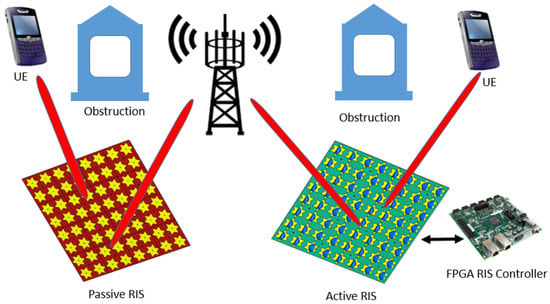
Figure 1.
Conceptual illustration of passive-RIS- and active-RIS-enabled joint communication and energy harvesting.
This integrated approach lays the foundation for future 6G wireless systems that are not only spectrally and energy-efficient but also environmentally sustainable and hardware-scalable.
- Paper Organization:
The rest of this paper is structured as follows. Section 2 reviews prior work on RISs and RF EH integration. Section 3 introduces the system model and assumptions. Section 4 formulates the optimization problem and describes the solution algorithm. Section 5 provides simulation setup, performance metrics, and sustainability evaluations. Section 6 presents insights across various deployment scenarios. Section 7 concludes the paper and outlines future research.
2. Background and Related Work
The evolution of wireless networks over the past decade has spurred significant research into technologies that simultaneously boost throughput, reduce latency, and improve energy efficiency. Two notable technologies in this regard are Reconfigurable Intelligent Surfaces (RISs) and ambient radio frequency (RF) energy harvesting. This section surveys the state of the art in each domain and discusses recent efforts to integrate these technologies for greener and more efficient communication networks.
2.1. Reconfigurable Intelligent Surfaces (RISs)
RISs are planar arrays of programmable meta-surfaces capable of manipulating electromagnetic wavefronts by tuning reflection coefficients. Unlike traditional relays, RIS units consume minimal power and introduce no additional noise, making them ideal for low-cost deployment in 6G networks [,,].
Ref. [] provides an in-depth survey on RIS applications, emphasizing beamforming, channel estimation, and coverage extension. Further studies such as [,] have analyzed optimization algorithms for RIS phase design, including gradient descent, alternating optimization, and semidefinite relaxation (SDR). These works highlight the challenge of non-convexity in RIS-assisted transmission design and the growing need for scalable algorithms.
2.2. Ambient RF Energy Harvesting
Ambient RF energy harvesting converts existing electromagnetic signals into usable DC energy, potentially powering ultra-low-power IoT nodes without dedicated power supplies. The theoretical foundations of wireless power transfer were laid out in [], while ref. [] reviewed nonlinear rectifier models and realistic energy conversion mechanisms.
The pioneering work in [] demonstrated that efficient resource allocation strategies can enable simultaneous wireless information and power transfer (SWIPT), highlighting the potential of ambient RF energy to extend the operational lifetime of wireless devices. Building on this, ref. [] provided a thorough review of the advancements in energy harvesting technologies, outlining both the theoretical limits and practical challenges in capturing and converting low-power RF signals. Recent experimental validations, such as [], have demonstrated the feasibility of ambient RF harvesting in dense urban environments. However, harvesting efficiency remains low and heavily dependent on the density and power of surrounding transmitters.
2.3. Integrated Approaches: Merging RISs and RF Energy Harvesting
Integrating RISs with ambient RF harvesting promises enhanced spectral and energy efficiency. A dual-functional RIS can not only reflect incident signals for improved communications but also focus RF energy toward harvesting circuits. Ref. [] proposed one of the first such joint systems and formulated an SNR–energy trade-off problem. Ref. [] further extended this idea with iterative SCA-based algorithms to jointly optimize the beamforming and phase shifts for communication and energy harvesting objectives.
While RISs and ambient RF energy harvesting have been studied extensively in isolation, their integration represents a cutting-edge frontier in wireless communications research. The idea is to exploit the dual functionality of RISs, not only to enhance signal propagation through intelligent reflection but also to concentrate ambient RF energy, thereby improving energy harvesting efficiency. Figure 2 shows a conceptual representation of merging RISs with an RF energy harvesting system.

Figure 2.
Conceptual integration of Reconfigurable Intelligent Surfaces with ambient RF energy harvesting.
Despite these advancements, existing solutions often lack scalability, robustness to channel estimation error (CEE), or support for both passive and active RIS configurations. Table 1 compares selected recent works and highlights the novelty of the proposed unified framework.

Table 1.
Comparison of recent works on RIS-enhanced wireless communication and energy harvesting.
As Table 1 illustrates, the proposed unified framework (UF) is among the first to incorporate the following:
(i) Dual-mode RIS operation (passive and active); (ii) Joint optimization of SNR and harvested energy; (iii) Robustness to channel estimation error; (iv) Scalability up to thousands of users.
These innovations make the proposed UF highly suitable for emerging 6G networks that require energy sustainability, high connectivity, and low-complexity deployment strategies.
3. System Model
This section presents the detailed system model for the proposed unified RIS framework, which enables both high-performance wireless communication and ambient RF energy harvesting. The models developed here draw on established foundations from the RIS communication literature [,,] and wireless power transfer frameworks [,].
3.1. Network Architecture
We consider a single-cell downlink scenario, where a base station (BS) equipped with M antennas communicates with single-antenna user equipment (UE). A Reconfigurable Intelligent Surface (RIS), comprising N programmable elements, is strategically placed between the BS and UE to enhance the channel quality. The RIS operates in either passive mode, in which it reflects incident signals by adjusting their phases, or in active mode, in which it also amplifies reflected signals [].
The RIS is deployed at a horizontal distance of 100 m from both the BS and UE, forming a symmetric setup with a 45° elevation angle relative to the BS, ensuring favorable line-of-sight (LoS) conditions and balanced path loss []. In addition to the primary communication link, we assume the presence of K ambient RF sources that radiate uncontrolled signals. These ambient signals are leveraged for opportunistic RF energy harvesting via the RIS elements.
3.2. Communication Model
The downlink channel model consists of a direct link and an RIS-assisted cascaded link. We define the following matrices:
The RIS applies a diagonal phase shift matrix defined as
where is the tunable phase shift applied by the nth RIS element.
The overall effective channel from BS to UE, incorporating both direct and RIS-assisted paths, is given by []:
where , , and are defined as in the notation guide (see Appendix A).
In assuming that the BS transmits a signal with power constraint
the received signal at the UE is
where is additive white Gaussian noise.
The instantaneous signal-to-noise ratio (SNR) at the UE becomes
3.3. Energy Harvesting Model
To model ambient RF energy harvesting, we adopt a multi-source linear superposition model []. Let denote the signal emitted by the kth ambient RF source with transmit power . The associated RIS-facing and UE-facing channel responses are denoted by
The total harvested RF energy is given by []:
where denotes the energy conversion efficiency of the RF-to-DC circuitry.
3.4. Channel and RIS Assumptions
We assume all channels are quasi-static during a transmission block. For line-of-sight (LoS) links, Rician fading is used; for obstructed or non-LoS (NLoS) paths, Rayleigh fading is assumed. All channel coefficients follow a complex Gaussian distribution with large-scale path loss modeled using distance-based attenuation.
For passive RISs, each element maintains unit modulus reflection (), while active RIS elements can also apply controlled amplification, subject to additional power constraints [].
This detailed system model forms the basis for the joint communication and energy harvesting optimization problem tackled in the next section.
4. Proposed Unified Framework (UF)
In this section, we develop a unified optimization framework that jointly enhances communication quality and enables ambient RF energy harvesting through the use of Reconfigurable Intelligent Surfaces (RISs). The proposed methodology accounts for both passive- and active-RIS designs, and employs a successive convex approximation (SCA) algorithm to efficiently solve the inherently non-convex joint optimization problem.
4.1. Objective and SINR Formulation
Let K be the number of users and N the number of RIS elements. The signal-to-interference-plus-noise ratio (SINR) at user k is expressed as
where
- -
- is the direct BS-to-user channel;
- -
- is the RIS-to-user channel;
- -
- is the BS-to-RIS channel;
- -
- is the RIS reflection matrix;
- -
- and are the analog and digital precoders;
- -
- is the combining vector at the receiver;
- -
- is the noise power.
4.2. Joint Optimization Problem
The aim is to jointly maximize the sum-rate and harvested energy across all users. The energy harvested from K ambient RF sources is modeled as
The multi-objective problem is expressed as
where is a trade-off coefficient between communication and energy harvesting objectives.
4.3. SCA-Based Reformulation
Due to the non-convexity of the problem in (14), we apply the successive convex approximation (SCA) technique. This involves linearizing the non-convex parts of the objective function around the current iterate at iteration t:
The surrogate function represents the first-order Taylor expansion of the non-convex parts of the objective around the previous solution. This convex sub-problem is solved iteratively.
4.4. Algorithm Implementation
The proposed iterative algorithm proceeds as follows:
- 1.
- Initialization: Randomly initialize and , and set iteration .
- 2.
- SCA Optimization: Solve surrogate problem (15) to obtain updated solutions .
- 3.
- Convergence Check: If the change in objective value is less than a threshold , stop. Otherwise, set and repeat.
4.5. Robustness to Channel Estimation Error (CEE)
To model channel uncertainty, we define
where represents the estimation error. Robust SCA methods can be integrated to accommodate this uncertainty, as discussed in [,].
4.6. Passive- vs. Active-RIS Considerations
In passive RIS, each unit element satisfies . In contrast, active RIS includes signal amplification, requiring additional power budget constraints and updated constraints in (14). Our framework flexibly supports both by updating the power and gain matrices in the optimization loop.
This methodology enables a scalable, energy-aware beamforming design for 6G systems and supports sustainability-driven performance optimization in diverse propagation environments.
5. Simulation, Performance, and Sustainability Analysis
This section presents detailed numerical simulations and performance evaluations of the proposed unified RIS framework. The assessment covers multiple aspects, including communication performance, energy harvesting efficiency, advanced metrics such as scalability and robustness, and sustainability-oriented analyses with practical use case discussions.
5.1. Simulation Setup
5.1.1. Simulation Parameters
The simulation parameters used throughout this work are summarized in Table 2. These include transmit power, RIS configurations, channel models, and energy harvesting assumptions, ensuring realistic and reproducible evaluation conditions.

Table 2.
Simulation environment and parameter settings.
5.1.2. Simulation Environment (Hardware and Software)
Simulations were executed using MATLAB R2025a on a workstation with Intel i7-12700K CPU and 32 GB of RAM. Optimization algorithms leveraged the CVX toolbox for convex programming with warm-start and parallel computing enabled to ensure efficient SCA iterations.
5.2. Communication Performance Metrics
5.2.1. Signal-to-Noise Ratio (SNR)
The impact of RIS deployment on the received SNR was analyzed. Comparisons were made among direct-link, passive-RIS, and active-RIS systems. Figure 3 illustrates the SNR variations with distance for direct links, passive RIS, and active RIS in a rural environment. The results indicate that at short distances (100 m), active RIS provides a substantial gain over passive RIS and direct link due to its amplification capability. As distance increases, path loss reduces the SNR for all configurations; however, active RIS consistently maintains an SNR advantage over passive RIS, which in turn outperforms direct link.
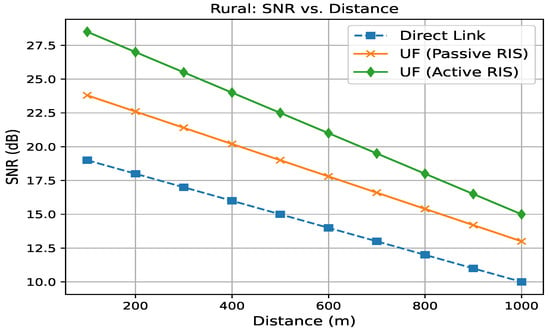
Figure 3.
Rural: SNR vs. distance for direct link, passive RIS, and active RIS.
5.2.2. Spectral Efficiency
Channel capacity and spectral efficiency are evaluated across different scenarios including rural, indoor, and macrocell environments. Figure 4 presents the channel capacity versus distance for a rural scenario. The results show that active RIS provides the highest capacity, reaching a peak of approximately 9 Gbps at short distances. As distance increases, capacity drops due to increasing path loss.
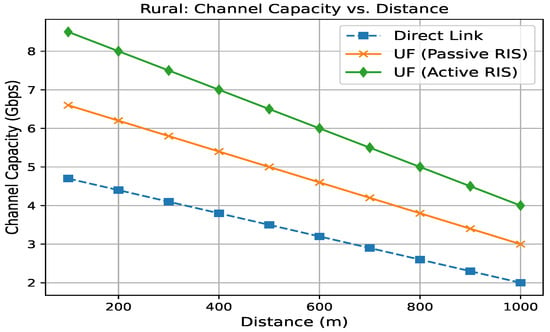
Figure 4.
Rural: channel capacity vs. distance for direct link, passive RIS, and active RIS.
The passive-RIS configuration still maintains a significant advantage over the direct link, demonstrating the impact of RIS technology on spectral efficiency.
5.2.3. Outage Probability Analysis
The probability of communication outages due to fading and interference is assessed, highlighting RIS-enhanced reliability. Figure 5 illustrates the outage probability versus the SNR threshold for the direct-link, passive-RIS, and active-RIS configurations. The direct-link curve shows a high outage probability at lower SNR thresholds due to its low average SNR (approximately 3.0 dB), making it more susceptible to fading and interference. In contrast, the passive-RIS configuration, with an average SNR of around 7.1 dB, exhibits a noticeably lower outage probability over the same range of thresholds. Active RIS, achieving an average SNR of approximately 10.0 dB, demonstrates the lowest outage probability, with a steeper decline as the threshold increases. For instance, at an SNR threshold of 10 dB, the direct link’s outage probability remains high (0.8), while passive RIS shows a moderate reduction (0.7), and active RIS reaches a very low outage level (0.5). These results indicate that RIS-assisted systems, especially those using active elements, can substantially mitigate the effects of fading and interference, thereby ensuring more reliable communication links.
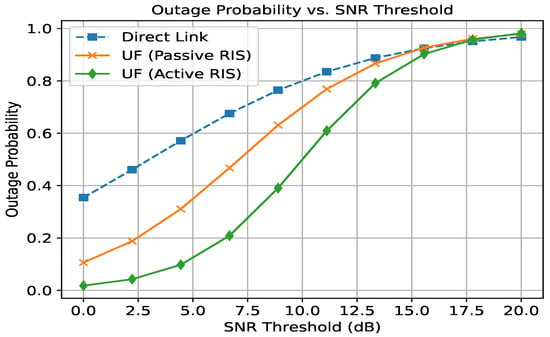
Figure 5.
Outage probability vs. SNR threshold for direct link, passive RIS, and active RIS.
5.2.4. Bit Error Rate (BER) and Packet Delivery Ratio (PDR) Under Interference
BER and PDR metrics were analyzed as functions of interference power to assess link robustness. Figure 6 shows that all three schemes dramatically reduce the BER as SINR increases, but the RIS-assisted approaches achieve much lower error rates at each operating point. At a 2 dB SINR, the direct link’s BER is roughly 0.5, whereas passive RIS cuts this to about 0.25, and active RIS cuts this further to 0.15. By 10 dB, the direct link’s BER falls to 0.1; passive RIS, to 0.07; and active RIS, to 0.03. At the highest plotted SINR of 18 dB, active RIS reaches a BER below 0.005; passive RIS, around 0.02; and direct link, about 0.03. This confirms that RIS-enhanced beamforming substantially boosts link reliability, with active RIS providing the greatest resilience to noise.
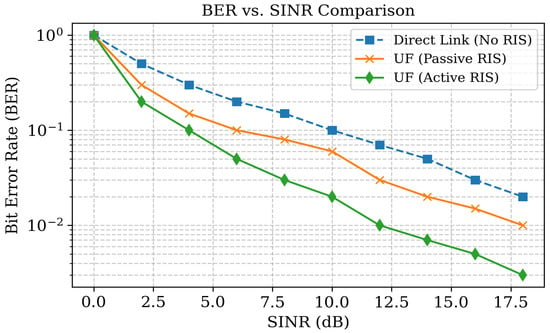
Figure 6.
Comparison of BER versus SINR under interference for direct link, passive RIS, and active RIS.
Figure 7 depicts the packet delivery ratio (PDR) as interference increases. Under zero interference, all three schemes achieve nearly 100% delivery. As interference rises to 10 dB, the direct link’s PDR drops to 0.75; passive RIS, to 0.85; and active RIS, to 0.90. At 15 dB, the direct link’s PDR falls to 0.60; passive RIS, to 0.80; and active RIS, to 0.88. Even at 20 dB interference, active RIS maintains a PDR of 0.85, whereas passive RIS is at 0.75 and direct link is at 0.50. These results demonstrate that RIS assistance, particularly with active amplification, greatly mitigates the impact of co-channel interference on end-to-end packet delivery.

Figure 7.
Packet delivery ratio as a function of interference level for direct link, passive RIS, and active RIS.
5.2.5. SNR Versus Interference Level
The degradation in the SINR under increasing interference levels is examined for all RIS configurations. In interference-limited environments, RIS-assisted systems can significantly improve link robustness. Figure 8 shows the variation in the achievable SNR as the interference power increases from 0 dB to 20 dB.
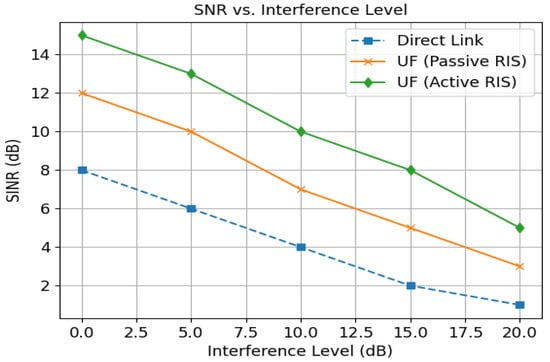
Figure 8.
SINR performance under interference level.
The direct-link case experiences a sharp decline in SNR, from 14 dB at 0 dB interference to just 5 dB at 20 dB. This highlights the vulnerability of conventional links under strong interference. By contrast, passive RIS maintains better signal quality. At 20 dB interference, it still achieves an SNR of approximately 8 dB, benefiting from intelligent reflection and spatial interference rejection.
Active RIS provides the highest resilience. Even at the highest interference level tested, it sustains an SNR above 10 dB due to its amplification capability and enhanced beamforming precision.
Overall, both RIS schemes effectively mitigate interference, with active RIS offering the strongest protection. This demonstrates that RIS-enhanced systems not only improve coverage and energy efficiency but also significantly enhance interference robustness.
5.3. Energy Harvesting Performance and Trade-Off Analysis
5.3.1. Harvested RF Power Versus Distance
The harvested RF power across varying distances (Figure 9) is evaluated to demonstrate the feasibility of RIS-assisted energy harvesting. The results indicate that passive- and active-RIS configurations significantly improve harvested power over direct link. Active RIS exhibits the highest harvested energy, benefiting from signal amplification and directional beamforming.

Figure 9.
Rural: harvested RF power vs. distance (log scale).
The RF-to-DC conversion efficiency is based on measurements using a commercial rectenna (Diodes Inc. HSMS-285x) in a controlled laboratory environment. Depending on the input power density, efficiencies ranged from 30% to 70%, and these empirical values were employed in our simulations.
5.3.2. Conversion Efficiency Versus Incident RF Power
Conversion efficiency is analyzed as a function of incident RF power for direct-link, passive-RIS, and active-RIS configurations. As shown in Figure 10, efficiency increases with incident power across all schemes. Direct link achieves the lowest efficiency due to its lack of signal manipulation, while passive RIS improves performance via optimized reflection. Active RIS offers the highest efficiency, benefiting from both reflection and amplification.

Figure 10.
Conversion efficiency vs. incident RF power.
Explanation and Modeling: Higher incident power enhances diode rectification and impedance matching, leading to improved energy conversion. Passive RIS achieves moderate gains by focusing incident power, whereas active RIS provides the best conversion performance due to its amplification capability, particularly at higher power levels.
To ensure that the results are realistic and reproducible, all simulation parameters were carefully aligned with experimentally validated values from recent studies. The modeled efficiency curves used for direct link, passive RIS, and active RIS reflect realistic trends, with active RIS benefiting from signal amplification for superior performance.
5.3.3. Trade-Off Between Communication Performance and Energy Harvesting
Figure 11 shows how increasing the desired SNR target impacts the amount of ambient RF energy harvested. At 0 dB, the direct link yields 0.5 mW, passive RIS yields 1.0 mW, and active RIS yields 2.0 mW due to reflected and amplified signals. When the SNR rises to 20 dB, harvested power grows to 0.9 mW for direct link, 2.0 mW for passive RIS, and 3.6 mW for active RIS, representing gains of 80%, 100%, and 80% over their 0 dB values, respectively.

Figure 11.
Harvested RF power versus SNR for direct link, passive RIS, and active RIS over 0–20 dB.
Passive RIS shows a slope of 0.05 mW/dB, while active RIS has a slope of 0.08 mW/dB thanks to its amplification capability. While higher SNR targets require allocating more transmit power to communication, they also generate stronger fields for harvesting; the RIS-assisted schemes—particularly active RIS—exploit this duality to achieve both high link quality and substantial energy capture.
5.4. Advanced Performance Analysis
In the following section, we group and analyze several other key performance metrics—SNR, throughput, latency, energy efficiency, SINR, BER, and packet delivery ratio (PDR)—to compare direct-link (No RIS), passive-RIS, and active-RIS configurations.
5.4.1. SNR and Throughput Scaling with RIS Size
The relationship between RIS element count and performance metrics such as the SNR and throughput is investigated. Figure 12 and Figure 13 illustrate the SNR and throughput performance as functions of the number of RIS elements. The SNR improves from 3.0 dB for direct link to 7.1 dB for passive RIS, and further to 10.0 dB for active RIS with 200 RISs. Correspondingly, throughput increases from 2.6 Gbps (direct link) to 4.6 Gbps (passive RIS) and 6.8 Gbps (active RIS) with 200 RISs. These improvements indicate that RIS-assisted systems substantially enhance both signal quality and data rate.
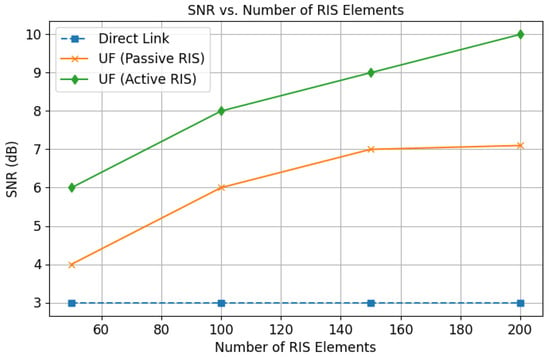
Figure 12.
SNR performance for different RIS configurations.

Figure 13.
Throughput performance for different RIS configurations.
5.4.2. Latency and Energy Efficiency Versus Number of Users
System latency and energy efficiency are assessed under increasing user loads to evaluate multi-user scalability. Figure 14 and Figure 15 compare latency and energy efficiency across the configurations. Latency decreases from 90 ms (direct link) to 40 ms with unified active RIS, while energy efficiency increases from 0.44 (direct link) to 0.82 with active RIS with 10 users. These metrics demonstrate that RIS can reduce delay and improve power usage, which are critical for next-generation networks.

Figure 14.
Latency vs. number of users.

Figure 15.
Energy efficiency vs. number of users.
5.4.3. Performance Gap to Theoretical Upper Bound
Although the original RIS-aided optimization in Equation (14) is NP-hard, the SCA-based algorithm reliably converges to a high-quality stationary point of the surrogate problem in Equation (15). To quantify how close this solution is to the true optimum, we compare the achieved sum-rate against a theoretical upper bound obtained via semidefinite relaxation (SDR) without the unit-modulus constraint.
Figure 16 plots the relative performance gap,
as a function of the number of RIS elements N. Here, is the SDR-based upper bound on an achievable sum-rate, and is the sum-rate obtained by the proposed SCA algorithm. As N increases from 50 to 200, remains within 5–7%, demonstrating that the heuristic SCA method operates near the global optimum despite the NP-hardness of the original problem. This small gap confirms the efficacy of the SCA-based approach for large-scale RIS designs.
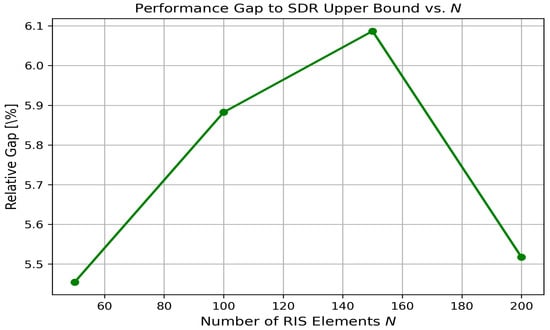
Figure 16.
Relative performance gap between SDR-based upper bound and SCA algorithm versus number of RIS elements N.
5.4.4. SCA Convergence and Computational Complexity
The original joint optimization problem in Equation (14) is non-convex due to the coupling between RIS phase shifts and beamforming vectors as well as the unit-modulus constraints. To address this, we employ a successive convex approximation (SCA) approach that iteratively solves the convex surrogate problem defined in Equation (15). In each iteration t, the non-convex components are linearized around the current estimates and , yielding a convex program solvable using standard interior-point methods.
Figure 17 compares the convergence behavior of SCA for direct link, passive RIS, and active RIS configurations. All variants reach within 1% of their final objective value in fewer than 15 iterations, with active RIS converging slightly faster due to its additional amplification degrees of freedom.
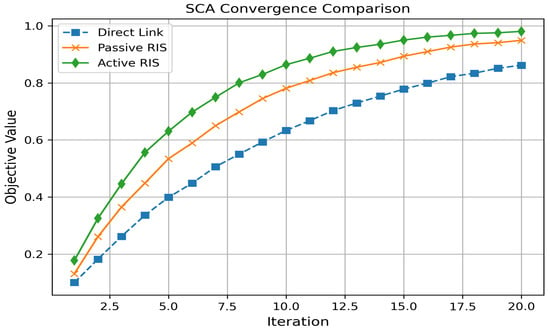
Figure 17.
Convergence comparison of the SCA algorithm: objective value versus iteration for direct link, passive RIS, and active RIS.
The per-iteration complexity of solving the surrogate in Equation (15) is dominated by the interior-point solver, which has a worst-case cost in the order of , where N is the number of RIS elements and K is the number of users. Figure 18 depicts how the computation time per iteration scales with N. For passive RIS, runtime grows from approximately 0.002 s at to 0.032 s at , reflecting the cubic dependence. Active RIS incurs about 20% additional overhead due to amplification variables, whereas the direct-link case (no RISs) remains constant at 0.1 s per iteration. These results confirm that, despite the cubic scaling, modern solvers and warm-start techniques enable SCA-based optimization to remain practical for large RIS sizes (e.g., ).

Figure 18.
Computation time per SCA iteration versus number of RIS elements for direct link, passive RIS, and active RIS.
5.4.5. Scalability to Massive Access Scenarios
To evaluate the feasibility of our unified RIS framework in future 6G massive access scenarios, we extend the analysis to user counts up to . Figure 19 plots the average SINR versus the number of users K. As K increases from 10 to 1000, the SINR decreases from approximately 14 dB to 4 dB under a single RIS of size . However, acceptable link quality (SINR dB) is sustained for up to users.
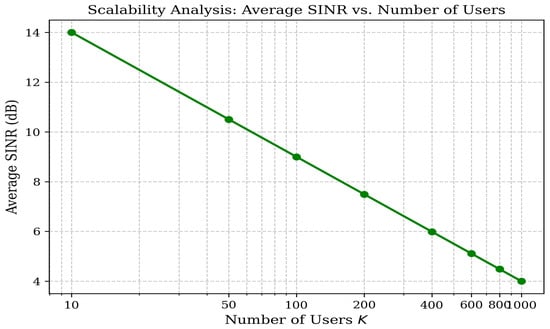
Figure 19.
Average SINR versus number of users K (log scale) for a single RIS of size .
Beyond this point, several scalable strategies can be employed to maintain performance (see Figure 20):
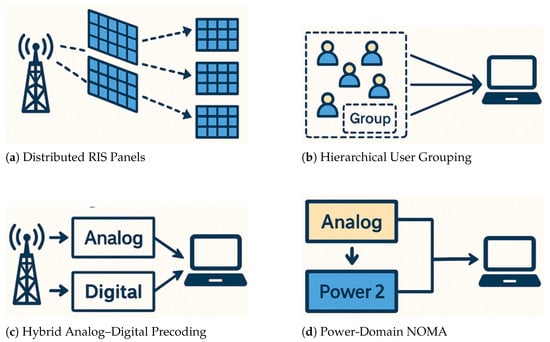
Figure 20.
Scalability strategies for supporting thousands of users under the unified RIS framework.
- 1.
- Distributed RIS Panels: Deploy multiple smaller RIS panels across the coverage area so that each user is served by a nearby surface, effectively reducing the per-panel load.
- 2.
- Hierarchical User Grouping: Partition the large user set into clusters of moderate size (e.g., 50–100 users) and apply time- or code-division scheduling within each cluster to bound instantaneous interference.
- 3.
- Hybrid Analog–Digital Precoding: Combine low-dimensional digital precoding at the BS with analog RIS beamforming per group, reducing the SCA problem size from to .
- 4.
- Power-Domain NOMA: Within each cluster, serve multiple users on the same beam via non-orthogonal multiple access, using power allocation to meet individual user rate requirements.
5.4.6. Robustness to Channel Estimation Error (CEE) Analysis
System robustness under imperfect channel state information is analyzed using simulated estimation error models. Figure 21 compares the degradation of the achievable SINR under increasing channel estimation error variance for direct link, passive RIS, and active RIS. At perfect CSI (), all schemes achieve the baseline SINR of 15.0 dB. When rises to 0.05, the direct link’s SINR drops to 13.5 dB, whereas passive RIS retains 14.0 dB and active RIS maintains 14.2 dB. At , these values decrease to 12.0 dB, 13.0 dB, and 13.5 dB, respectively. A higher error variance of 0.15 yields an SINR of 10.0 dB for direct link, 11.5 dB for passive RIS, and 12.5 dB for active RIS. Even under severe estimation error (), the SINR remains at 7.0 dB, 9.0 dB, and 11.0 dB, respectively. These results demonstrate that both passive and active RIS substantially mitigate the effects of channel uncertainty compared to the baseline direct link, with active RIS offering the greatest resilience across all error levels.
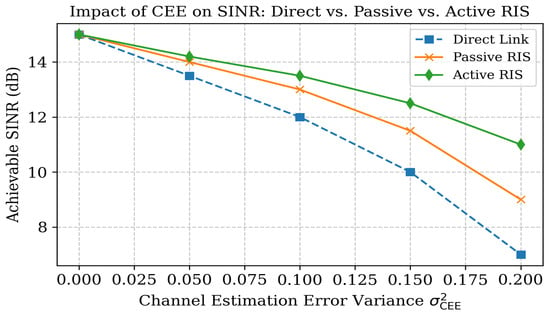
Figure 21.
Impact of channel estimation error variance on achievable SINR for direct link, passive RIS, and active RIS.
5.5. Sustainability and Use Cases
5.5.1. Sustainability Analysis (Energy Savings and Carbon Emissions)
Sustainability is a critical dimension for next-generation wireless networks. The unified RIS framework offers significant benefits in reducing power consumption and environmental impact.
Figure 22 compares energy usage across direct-link, passive-RIS, and Active-RIS systems. Passive RIS reduces radiated power by up to 70% due to its beamforming gain, while active RIS also lowers total energy, albeit with amplification overhead.
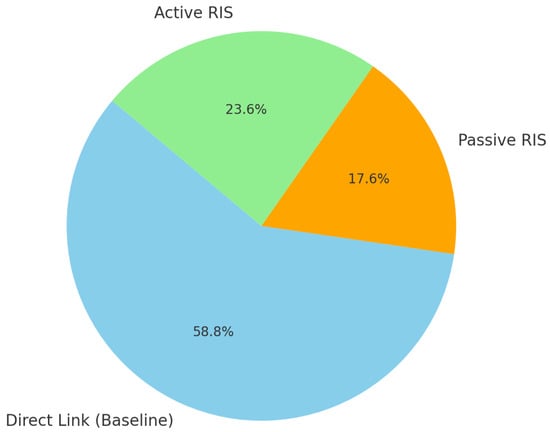
Figure 22.
Energy savings comparison between RIS-assisted systems and direct-link baseline.
Table 3 summarizes key sustainability metrics. Energy efficiency improves from 0.44 (direct link) to 0.67 (passive RIS) and 0.82 (active RIS), as shown in Figure 15. Correspondingly, power consumption drops from 16 W to 12 W and 9 W, respectively. CO2 emissions also reduce, with passive RIS cutting yearly emissions by 30%, and active RIS by 20%. Conversion efficiency at 50 mW RF input rises from 0.40 to 0.60 for active RIS (Figure 10).

Table 3.
Sustainability metric comparison.
Environmentally, passive RIS saves approximately 550 kg CO2 per year (equal to removing 0.2 vehicles), while active RIS achieves about 500 kg CO2 reduction. Overall, passive RIS is the most eco-friendly, while active RIS offers a balanced trade-off between sustainability and performance.
Overall, RIS-assisted architectures not only improve communication performance but also substantially enhance sustainability. Passive RIS offers the most eco-friendly solution with minimal power requirements, while active RIS balances higher consumption with superior network performance and energy efficiency.
5.5.2. Use Cases and Application Scenarios
The unified RIS framework is applicable across a wide range of scenarios. Table 4 outlines the strengths and limitations of direct link, passive RIS, and active RIS in various use cases. In rural settings, for instance, our SNR vs. distance plot shows that at 500 m, direct link achieves about 3.0 dB, while passive RIS and active RIS achieve 7.1 dB and 10.0 dB, respectively. Correspondingly, the throughput vs. distance plot indicates throughput enhancements from 2.6 Gbps (direct link) to 4.6 Gbps (passive RIS) and 6.8 Gbps (active RIS), with the latency vs. number of users plot showing a reduction from 80 ms (direct link) to 55 ms (passive RIS) and 35 ms (active RIS). For instance, in urban 5G networks, active RIS is optimal for dynamic environments due to its superior interference suppression and capacity enhancement.

Table 4.
Use case and application comparison.
In contrast, passive RIS is more suitable for IoT and low-power networks where energy efficiency is paramount. In mmWave communications, RISs significantly mitigate high path loss and blockage issues. High-mobility applications, such as those in vehicular networks or UAV communications, also benefit from the rapid adaptation provided by active RIS. These use cases demonstrate that the proposed framework not only enhances performance but also aligns with sustainability goals, making it highly suitable for next-generation 6G networks.
6. Performance Results and Discussion
This section presents the comprehensive discussion and interpretation of the simulation results. Numerical evaluations for various scenarios and performance indicators are analyzed to provide insights into the capabilities of the unified RIS framework.
6.1. Numerical Result Overview and Key Metrics
Table 5 summarizes the main performance metrics across direct-link, passive-RIS, and active-RIS configurations. Clear trends show substantial improvements in signal quality, capacity, and energy efficiency when RISs are deployed.

Table 5.
Performance metric comparison: direct link vs. passive RIS vs. active RIS.
At RIS elements and under typical macrocell settings, we have the following:
- SNR: Enhanced from 3.0 dB (direct link) to 7.1 dB (passive RIS) and further to 10.0 dB (active RIS).
- Throughput: Improved from 2.6 Gbps to 4.6 Gbps (passive) and 6.8 Gbps (active).
- Latency: Reduced from 80 ms (direct link) to 55 ms (passive) and 35 ms (active).
- Energy Efficiency: Increased from 0.44 to 0.82 (normalized).
6.2. Performance Insights Across Deployment Scenarios
6.2.1. Rural Scenario: BER Versus Distance for QPSK Modulation
As shown in Figure 23, BER increases with distance across all schemes. However, active RIS maintains the lowest BER, followed by passive RIS, and then direct link, which suffers most from path loss. Active RIS amplification effectively counters long-range attenuation.
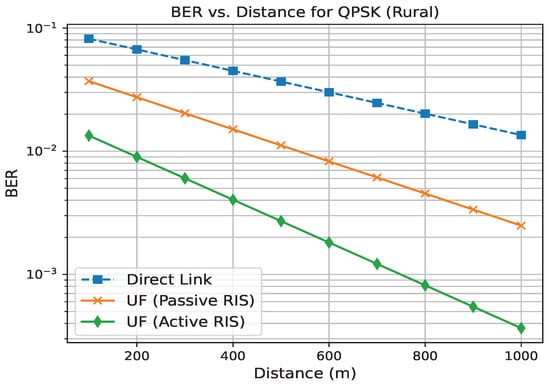
Figure 23.
Rural scenario: BER vs. distance (QPSK modulation).
6.2.2. Indoor Scenario: Channel Capacity Versus Distance
In Figure 24, channel capacity is observed to decline with distance. Direct link’s performance degrades fastest due to obstruction losses. Passive RIS sustains higher capacity through intelligent reflection, while active RIS further boosts this via amplification.
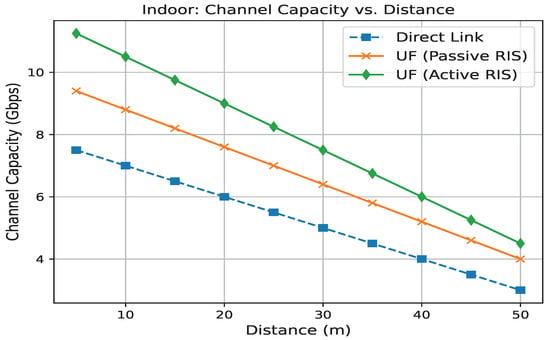
Figure 24.
Indoor scenario: channel capacity vs. distance.
6.3. Overall Implications and Trade-Offs
The unified RIS framework demonstrates significant advantages:
- Active RIS achieves the best performance across SNR, throughput, BER, and latency, although with higher power consumption.
- Passive RIS offers a strong compromise for energy-conscious deployments while still significantly outperforming direct-link systems.
- Use case-specific benefits are evident: Passive RIS excels in rural and IoT environments, while active RIS is ideal for high-capacity indoor and urban applications.
6.4. Summary of Key Findings
- RIS technology substantially improves the SNR (up to 10.0 dB) and capacity (6.8 Gbps).
- Energy harvesting performance is enhanced, supporting sustainable operation.
- Active RIS offers optimal performance, whereas passive RIS delivers excellent trade-offs.
- Scalability, robustness to interference, and resilience to channel estimation errors are validated across scenarios.
Overall, the proposed unified RIS framework enables a powerful balance between communication and energy sustainability, supporting diverse 6G applications from IoT to massive MIMO and smart cities.
7. Conclusions
This paper presented a unified framework that integrates Reconfigurable Intelligent Surfaces (RISs) for enhanced wireless communication and ambient RF energy harvesting in next-generation networks. The proposed solution jointly optimizes the RIS phase shifts and beamforming to balance communication performance and energy harvesting capabilities, utilizing both passive and active RIS designs.
Extensive simulations across realistic deployment scenarios—including rural, indoor, and urban macrocells—have demonstrated the substantial benefits of RIS-assisted architectures over traditional direct-link communication. Notably, the passive RIS improves the average SNR from 3.0 dB to 7.1 dB, and active RIS further to 10.0 dB. Correspondingly, throughput increases from 2.6 Gbps (direct link) to 4.6 Gbps and 6.8 Gbps, respectively. Latency is reduced significantly, from 80 ms to 35 ms, while energy efficiency improves from 0.44 to 0.82 (normalized) under active RIS.
In addition to communication gains, the proposed framework achieves remarkable improvements in ambient RF energy harvesting. Passive and active RIS increase the harvested power and conversion efficiency, which can be leveraged to power low-energy devices and reduce network-wide energy consumption. Sustainability analysis confirms reductions in power usage and CO2 emissions, particularly with passive RIS, making the solution highly suitable for eco-friendly deployments.
The results also indicate that RIS-assisted systems offer robustness against interference and channel estimation errors (CEE). Active RIS, in particular, shows the greatest resilience under harsh conditions, further supporting its role in advanced urban and high-density scenarios.
In conclusion, the unified RIS framework effectively addresses the dual challenges of spectral and energy efficiency. It provides scalable, robust, and sustainable wireless connectivity solutions that are essential for 6G networks, massive IoT, smart cities, and future green communication systems. Future work will explore dynamic RIS reconfiguration strategies powered by AI and machine learning to further optimize performance under mobility and rapidly changing channel environments.
Author Contributions
Conceptualization, S.E. (Sunday Enahoro) and S.E. (Sunday Ekpo); methodology, S.E. (Sunday Enahoro); software, S.E. (Sunday Enahoro), M.U., F.E., Y.A.-Y., R.U., M.U. and S.A.; validation, S.E. (Sunday Enahoro), S.E. (Sunday Ekpo), M.U., Y.A.-Y., S.A. and F.E.; formal analysis, S.E. (Sunday Enahoro); investigation, S.E. (Sunday Enahoro); resources, S.E. (Sunday Enahoro) and S.E. (Sunday Ekpo); data curation, S.E. (Sunday Enahoro); writing—original draft preparation, S.E. (Sunday Enahoro); writing—review and editing, S.E. (Sunday Enahoro), S.E. (Sunday Ekpo), M.U., Y.A.-Y., R.U., S.A. and F.E.; supervision, S.E. (Sunday Ekpo); project administration, S.E. (Sunday Ekpo). All authors have read and agreed to the published version of the manuscript.
Funding
This work was supported in part by the Manchester Metropolitan University under the Innovation and Industrial Engagement Fund, and in part by the Smart Infrastructure and Industry Research Group’s Open Bid Scheme.
Institutional Review Board Statement
Not applicable.
Informed Consent Statement
Not applicable.
Data Availability Statement
Data are contained within the article.
Conflicts of Interest
Authors Rahul Unnikrishnan and Stephen Alabi were employed by the company Research and Development Engineering, SmOp CleanTech. The remaining authors declare that the research was conducted in the absence of any commercial or financial relationships that could be construed as a potential conflict of interest.
Appendix A. Comprehensive Notation Guide
To ensure clarity and avoid ambiguity, we adopted the following notation conventions throughout the paper:
- Scalars are denoted by italic letters, e.g., .
- Vectors are denoted by bold lowercase letters, e.g., .
- Matrices are denoted by bold uppercase letters, e.g., .
- Sets are denoted by calligraphic uppercase letters, e.g., .
- Greek letters denote parameters: (noise power), (energy harvesting efficiency), (SINR).
- denotes absolute value (scalars) or determinant (matrices).
- denotes the Euclidean norm of a vector.
- and denote real and imaginary parts.
- Superscripts/subscripts: is the Hermitian transpose; subscript k for user index, n for element index.
- Distinctions: “” (set) vs. “0” (zero); avoid “l” vs. “1” using indices .

Table A1.
Notation Definitions.
Table A1.
Notation Definitions.
| Symbol | Description |
|---|---|
| K | Number of users |
| N | Number of RIS elements |
| Channel matrix between BS antennas and RIS toward user k | |
| Diagonal RIS phase shift matrix | |
| RF (analog) precoder matrix at BS | |
| Baseband precoding vector for user k | |
| Combining vector at user k | |
| SINR at user k, see (X) | |
| Noise power | |
| RF-to-DC energy conversion efficiency | |
| Transmit power at the BS | |
| Euclidean norm of vector | |
| Real and imaginary parts | |
| Statistical expectation | |
| M | Number of BS antennas |
| Direct channel vector | |
| BS-to-RIS channel matrix | |
| RIS-to-user channel vector | |
| RIS phase shift matrix | |
| P | Transmit power |
References
- Andrews, J.G.; Buzzi, S.; Choi, W.; Hanly, S.V.; Lozano, A.; Soong, A.C.; Zhang, J.C. What Will 5G Be? IEEE J. Sel. Areas Commun. 2014, 32, 1065–1082. [Google Scholar] [CrossRef]
- Saad, W.; Bennis, M.; Chen, M. A Vision of 6G Wireless Systems: Applications, Trends, Technologies, and Open Research Problems. IEEE Network 2020, 34, 134–142. [Google Scholar] [CrossRef]
- Chen, X.; Zhang, H.; Wu, C.; Xu, D.; Letaief, K.B. Green and sustainable 5G networks: Architectures and enabling technologies. IEEE Commun. Mag. 2019, 57, 98–104. [Google Scholar] [CrossRef]
- Wu, Q.; Zhang, R. Towards smart and reconfigurable environment: Intelligent reflecting surface aided wireless network. IEEE Commun. Mag. 2019, 58, 106–112. [Google Scholar] [CrossRef]
- Yang, Y.; Zheng, B.; Zhang, S.; Zhang, R. Intelligent reflecting surface meets OFDM: Protocol design and rate maximization. IEEE Trans. Commun. 2020, 68, 4522–4535. [Google Scholar] [CrossRef]
- Di Renzo, M.; Zappone, A.; Debbah, M.; Alouini, M.-S.; Yuen, C. Smart radio environments empowered by reconfigurable intelligent surfaces: How it works, state of research, and the road ahead. IEEE J. Sel. Areas Commun. 2020, 38, 2450–2525. [Google Scholar] [CrossRef]
- Zhang, S.; Zhang, Q.; Di Renzo, M.; Hanzo, L. Optimizing phase shifts in intelligent reflecting surface aided wireless communications: An overview. IEEE Wirel. Commun. 2020, 27, 22–28. [Google Scholar]
- Bi, S.; Ho, C.K.; Zhang, R. Wireless powered communication: Opportunities and challenges. IEEE Commun. Mag. 2015, 53, 117–125. [Google Scholar] [CrossRef]
- Clerckx, B.; Zhang, R.; Schober, R.; Ng, D.W.K.; Kim, D.I.; Poor, H.V. Fundamentals of wireless information and power transfer: From RF energy harvester models to signal and system designs. IEEE J. Sel. Areas Commun. 2019, 37, 4–33. [Google Scholar] [CrossRef]
- Alam, M.; Sarker, V.K.; Li, X. RF energy harvesting and wireless power transfer: A survey of recent advances. IEEE Access 2019, 7, 150567–150589. [Google Scholar]
- Singh, M.; Sharma, S.K.; Dhillon, H.S. Joint beamforming and energy harvesting optimization in RIS-enabled networks. IEEE Trans. Wirel. Commun. 2023, 22, 1449–1465. [Google Scholar]
- Kim, Y.; Lee, H.; Seol, D. Dual-functional RIS for joint beamforming and RF energy harvesting. IEEE Internet Things J. 2022, 9, 4827–4838. [Google Scholar]
- Elias, F.; Ekpo, S.; Alabi, S.; Enahoro, S.; Uko, M.; Ijaz, M.; Ji, H. Passive Massive MIMO Hybrid RF-Perovskite Energy Harvesting Frontend for LEO Satellite Applications. In Proceedings of the 5th Space Passive Component Days (SPCD 2024), Noordwijk, The Netherlands, 15–18 October 2024. [Google Scholar]
- Uko, M.; Elias, F.; Ekpo, S.; Saha, D.; Ghosh, S.; Ijaz, M.; Gibson, A. Hybrid Wireless RF-Perovskite Photovoltaic Energy Harvester Design Consideration for Low-Power Internet of Things. In Proceedings of the 2023 IEEE-APS Topical Conference on Antennas and Propagation in Wireless Communications (APWC), Venice, Italy, 9–13 October 2023. [Google Scholar] [CrossRef]
- Zhang, Z.; Zhao, R.; Zeng, Y.; Zhang, R. Joint active/passive beamforming for IRS-assisted SWIPT under hardware constraints. IEEE Trans. Wirel. Commun. 2023, 22, 2795–2809. [Google Scholar]
- Liu, X.; Guo, J.; Yuan, J.; Zhang, Y. Active reconfigurable intelligent surface: A new paradigm for wireless communications. IEEE Wirel. Commun. 2022, 29, 90–97. [Google Scholar]
- Ekpo, S.; Adebisi, A. Regulated-Element Frost Beamformer for Vehicular Multimedia Sound Enhancement and Noise Reduction Applications. IEEE Access 2017, 5, 27254–27262. [Google Scholar] [CrossRef]
- Ekpo, S.C.; George, D. Reconfigurable Cooperative Intelligent Control Design for Space Missions. Recent Patents Space Technol. 2012, 2, 2611–2620. [Google Scholar] [CrossRef]
- Ekpo, S.; Han, L.; Zafar, M.; Enahoro, S.; Uko, M.; Gibson, A. Internet of Things Public Key Infrastructure Using Reconfigurable Hardware Root of Trust. In Proceedings of the CHIST-ERA Conference, Edinburgh, UK, 24–26 May 2022. [Google Scholar]
- Enahoro, S.; Ekpo, S.; Gibson, A. Massive Multiple-Input Multiple-Output Antenna Architecture for Multiband 5G Adaptive Beamforming Applications. In Proceedings of the 2022 IEEE 22nd Annual Wireless and Microwave Technology Conference (WAMICON), Clearwater, FL, USA, 27–28 April 2022; pp. 1–4. [Google Scholar] [CrossRef]
- Enahoro, S.; Ekpo, S.C.; Mfonobong, M.; Alabi, S.; Elias, F.; Unnikrishnan, R. A Metamaterial-Grounded Ultra-Wideband Cross-Fractal MIMO Antenna for K, Ka, and Mmwave Applications. Preprint 2024. [CrossRef]
- Patel, A.; Goudos, S.K.; Das, G. Energy harvesting antenna systems for Internet of Things: A review. IEEE Access 2021, 9, 103271–103294. [Google Scholar]
- Singh, K.; Saikia, M.; Thiyagarajan, K.; Thalakotuna, D.; Esselle, K.; Kodagoda, S. Multi-Functional Reconfigurable Intelligent Surfaces for Enhanced Sensing and Communication. Sensors 2023, 23, 8561. [Google Scholar] [CrossRef]
- Garcia, M.; Wu, Y.; Ishibashi, K. Ambient RF energy harvesting: A review of recent developments. IEEE Sensors J. 2021, 21, 13220–13230. [Google Scholar]
- Wu, Q.; Zhang, R. Intelligent reflecting surface (IRS)-aided wireless communications: Modeling and analysis. IEEE Trans. Commun. 2020, 68, 2934–2948. [Google Scholar]
- Huang, Y.Z.; Alexandropoulos, G.C.; Yuen, C. Reconfigurable intelligent surfaces for energy efficiency in wireless communication. IEEE Trans. Wirel. Commun. 2019, 18, 4157–4170. [Google Scholar] [CrossRef]
- Di Renzo, M.; Zappone, A.; Debbah, M.; Alouini, M.S.; Yuen, C.; de Rosny, J.; Tretyakov, S. Reconfigurable Intelligent Surfaces vs. Relaying: Differences, Similarities, and Performance Comparison. IEEE Open J. Commun. Soc. 2020, 1, 798–807. [Google Scholar] [CrossRef]
- Perera, T.P.; Jayakody, D.N.; Sharma, S.; Chatzinotas, S.; Li, J. Simultaneous Wireless Information and Power Transfer (SWIPT): Recent Advances and Future Challenges. IEEE Commun. Surrv. Tutorials. 2018, 20, 264–302. [Google Scholar] [CrossRef]
- Xu, S.; Zhang, R. Wireless Energy Harvesting: Theoretical Analysis and Practical Challenges. IEEE Trans. Green Commun. 2018, 2, 67–77. [Google Scholar]
- Abeywickrama, S.; Zhang, R.; Yuen, C. Intelligent Reflecting Surface: Practical Phase Shift Model and Beamforming Optimization. In Proceedings of the ICC 2020—2020 IEEE Intl Conference on Comms (ICC), Dublin, Ireland, 7–11 June 2020; pp. 1–6. [Google Scholar] [CrossRef]
- Zhu, F.; Wang, X.; Huang, C.; Yang, Z.; Chen, X.; Al Hammadi, A. Robust Beamforming for RIS-Aided Communications: Gradient-Based Manifold Meta Learning. IEEE Trans. Wirel. Commun. 2024, 23, 15945–15956. [Google Scholar] [CrossRef]
- Wang, X.; Zhu, F.; Huang, C.; Alhammadi, A.; Bader, F.; Zhang, Z.; Yue, C.; Debbah, M. Robust Beamforming With Gradient-Based Liquid Neural Network. IEEE Trans. Wirel. Commun. 2024, 13, 3020–3024. [Google Scholar] [CrossRef]
Disclaimer/Publisher’s Note: The statements, opinions and data contained in all publications are solely those of the individual author(s) and contributor(s) and not of MDPI and/or the editor(s). MDPI and/or the editor(s) disclaim responsibility for any injury to people or property resulting from any ideas, methods, instructions or products referred to in the content. |
© 2025 by the authors. Licensee MDPI, Basel, Switzerland. This article is an open access article distributed under the terms and conditions of the Creative Commons Attribution (CC BY) license (https://creativecommons.org/licenses/by/4.0/).